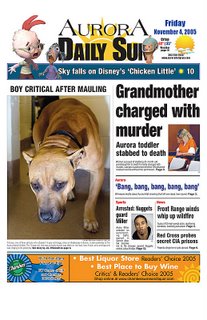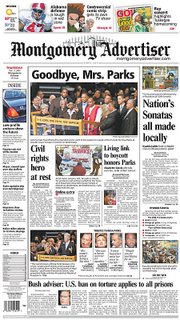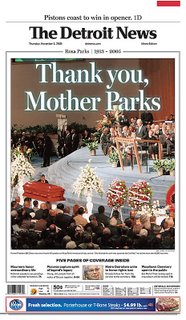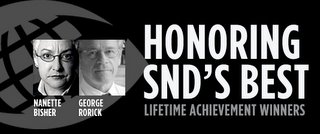In light of the latest circulation reports from ABC, I thought I'd preview my column from the upcoming SND Design magazine. Even though I wrote it two weeks ago, it probably won't be in mailboxes until sometime in January. You'd think we were printing
rotogravure in the '20s with that kind of lead time.
Anyway, my last president's column for Design. J.B. can breathe a sigh of relief for a couple of months before turning his sights to wringing it out of Christine.
Over the years, I’ve been involved in a number of conversations in which a colleague (or was it me?) defended their own decision or questioned another’s based on what was best for “the reader.”
Making informed decisions based on what you know about your readership is smart. Invoking “The Reader” isn’t. If such a monolithic, simplistic entity existed, our business would be so much easier — although a lot less interesting.
In this complex, quickly changing media environment, too often the capital R reader being discussed still looks amazingly like the journalist doing the talking. The target reader many of us seem most keen about is someone about our age, with remarkably similar interests, taste, experience, views. In short, “Me.”
(The other readership segments acknowledged by at least token action in newsrooms are “Immediate Family,” followed by “Neighbors and Friends” and someone named Martha who likes a good “talker.”)
Obviously, there’s nothing wrong with using your judgment and experience as a barometer. That’s what you’re paid to do and it’s an important part of the journalistic process. But it’s essential to also look beyond ourselves and the other journalists we navel gaze with.
Readers have been a big topic for years, although mostly as we bemoan their dwindling numbers twice a year when ABC announces the latest toll.
It’s a critical time to start putting the endless theoretical discussions we’ve been having into real changes in the paper — multi-faceted changes that stand a chance at having an impact across broad segments of readership.
While this is a challenging issue, it’s also one filled with opportunities. Don’t be fooled that a movement to a smarter, reader-based approach means you have to become obsequious. I’m talking about thoughtful, measured responses and not some knee-jerk embrace of a fad.
Somewhere between “spinach journalism” and “journaltainment” there’s a lot of room to do interesting work. Serious, probing, contextual journalism won’t get lost in the equation if you’re having a serious, probing, contextual discussion about readers.
As visual journalists, we need to look as hard at ourselves as we do reporters and line editors. What’s the difference between the editor I once heard about who insisted on running his own 35-inch column contained to the sports front five days a week or a designer who approaches a blank page simply as a canvas for their personal expression?
There are many palace lies in the world of journalism. But let’s at least start by getting this one on the table: Many journalists don’t read much of their own paper beyond what they’ve written and edited the day before.
Put aside the argument about whether this is appropriate (it’s not), and ask why this is. It’s not all that complex: They’re either not interested or don’t have the time and energy to ferret out the good stuff. How can we expect more of people outside the business? Newspapers have a distinguished history of not respecting readers’ time. Readers are increasingly returning the favor by spending their time elsewhere.
But this is the kind of general screed that you’ve heard before. Inside this most important issue of Design, you’ll find more specifics and read how others are trying to step up to the challenge. I know you’ll find it provocative and useful in your own discussions.
By the time you read this, my presidency in SND will be winding down, if not already over. On New Year’s Day, I hand over the party hats and noisemakers to the very capable Christine McNeal. These last couple months after the conference have been spent finishing or pushing forward on a few initiatives – some of them exquisitely bureaucratic but essential to our functioning behind the scenes, some more broad-based and incredibly important. Tops among the latter is our ethics policy, which we hope to post on the website in draft form soon.
A year goes by fast and presidents never get done all the things they want to. But my main priority was to upgrade the website and thanks to a bunch of people – notably Elise Burroughs and Matt Mansfield – we did just that. There are so many people I should thank, but the list would go on forever. And I hear Jonathon Berlin striking up the orchestra – the music letting me know my time here is over.
It’s been an honor being a part of the leadership of this organization. And it’s been an inspiration seeing the creativity, skill, passion and commitment of the members of this worldwide family of journalists.








